Wayne C. Allen's Blog, page 2
April 27, 2025
About I‑am-ness — 12 Ideas

I‑am-ness — One particularly interesting way to look at ourselves as human beings is to explore our free-flowing-ness versus our rigidity.
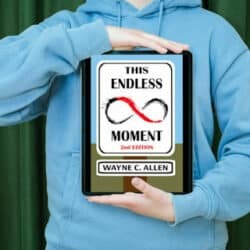
An excellent guide to life and living.
Learn to focus your attention of who you really are.
Read This Endless Moment now!
My “I‑am-ness” is limited only as I choose to limit myself. If I identify with “good/bad,” right/wrong lists, or with what others think or what others want, my “I‑am-ness” becomes a small, tight box. I must realize that I am not a noun. I am a verb. The question, then, is this: how much of my “I‑am-ing” will I bring into consciousness, and how much will I choose to live?

One particularly interesting way to look at ourselves as human beings is to explore our free-flowing-ness versus our rigidity.
As with everything else we’ve talked about, where you are on this scale is totally your choice. In other words, we choose between rigidity and flexibility.
And, equally important, who I am is absolutely and totally demonstrated by what I do.
There is often a vast difference between who I am and how I identify myself (who I say I am.)
While there’s no doubt that infants are born as blank slates, it’s also true that each infant has has a vast array of inborn talents and abilities. Much of this material is likely repressed, so most of us cart around piles of subconscious and unconscious material.
This “stuff” might be unexplored, but it has its ways of getting our attention. Dreams, strange inspirations, unexplained desires — these things have their roots in the unknown material.
Most of you know that Darbella taught grades seven and eight in what could be described as a middle school — a school just for seventh and eighth-graders. During her 30+ years at the school, two things remained the same — the kids entered as immature children and exited as somewhat mature t(w)eens.
Even more important, all but the strongest were forced into compliance with the “teen values” of the day through peer pressure.

It’s quite ironic.
It’s predictable that teens think they are stretching their wings, rebelling against parental norms, and standing on their own two feet, when all that’s really happening is that they are exchanging parental rules for the standards of their peers.
When you think about it, this is actually the process of all aspects of our socialization.
We get the first of it from our parents, the next part from our tribes (religious groups, neighbors, relatives, etc.) and the third part from our peers.
One researcher, Steven Pinker, suggests that, as far as influence goes, the ratio is 10% genetics, 40% parents, and 50% peers.
What happens, and it only differs in degree, is that more or less of our freedom, our “I‑am-ness,” is locked away behind the prison walls of societal norms.
The walls, the defenses, serve a twofold purpose: to keep the world at bay, and to keep ourselves in check. We feel threatened by “the great out there,” and fearful of the power of our own passion.
It thus seems safer to hide behind the rigid walls of our own making.This often comes out when clients blame others for their reluctance to make changes. Many are the excuses, the evasions, the equivocations — all of which add up to a deathly fear of living life fully.
For most, self responsible living is entirely too self responsible.
The resistance is twofold:
1) people resist by over-thinking — over-analyzing — as opposed to acting, and
2) people resist by tightening up their bodies, and through shallow breathing.
They thus create a person locked inside their own walls, something Wilhelm Reich called character armor.
Our approach, in a sense, is to knock loudly on the walls.
I’m sort of like a consultant on your home renovation project. I can tell you how to do it, and I will likely pick up the hammer and give you a demonstration, but the rest of the job, the hard slogging part, is up to you.
My refusal to do the job for you is a real problem — until you become self responsible.For all your life, someone has done the hard slogging for you. Or more likely, people have left you because you demanded that they do your work for you, and you’re still running around looking for someone to save you.
At the end of the day, however, you built the walls — and you conformed. It does not matter that you didn’t know what you were doing.
The way through the walls is to pay attention — to your dreams, to your hopes, to your aspirations — to the things that arise from inside.Open the door to the full possibilities of you. Explore your growing edges, your passions, your blockages, the hidden recesses that contain the things you really want to do and be.
Find yourself a Bodyworker or a deep tissue massage therapist to help you break through the character armor.
It’s the work of a lifetime to dismantle the walls that you have built up since you were born.This work requires constant vigilance, a sense of humor, and a willingness to get your hands dirty. It also requires enacting, in the real world, what you learn about yourself.
It may require drastically changing or leaving relationships, changing careers, or even moving to a new location or finding a new community. There is nothing simple, easy, or quick about any of this.
What you gain in self knowing, in “I‑am-ness,” is decidedly worth the effort.After all, walking around encased in armor, bearing the burden of the walls society and you have wrapped around you, means that being in the world is very hard indeed.
With dedicated effort, with focus, and with the help of the community of fellow walkers, true freedom, true relaxation, and true depth can be yours.
It’s what the world cries for.
Facebook TwitterApril 20, 2025
About Being Chained – 12 Ideas

About Being Chained – I must take full responsibility for my choices, decisions, and directions. Just as there is no one to compare myself to, there is no one is to blame for any choice I have ever made.

An excellent guide to life and living.
Learn to focus your attention of who you really are.
Read This Endless Moment now!
Back at point 1, I suggested the idea that you are the centre of your own universe. I wrote about “getting” that how we relate to others is sort of myopic. We think we are seeing clearly, but forget the glasses on our face.
I’d like to suggest another perspective for this idea, and it goes like this:
Every single aspect of what is happening in your life right now is the result of the choices you have made.
100% of the time.
Who you are, where you are, and how you are, it’s all determined by you, moment by moment.
This seems logical, until you unpack the implications.
We have been trained since birth to look outside of ourselves for both satisfaction and someone to blame.
Starting from where you are means accepting responsibility for the choices you made, and are making to get to this state — to this moment — to this condition.
Let me say it this way: this approach is not magical, not indirect, and not superficial.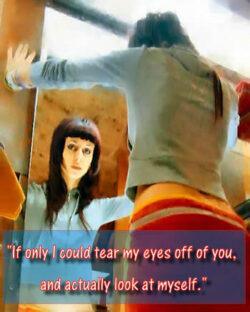
Many people think that therapy is about “making things all better,” as in “no problems.”
Only one client has ever said this aloud, in New Age-speak, when she said, “I need my affirmations fixed. I’m not getting what I want.”
But many clients expect that doing therapy is going to “easily fix the world.”
They think that their internal tightness and emotional issues are externally caused.I insist that how you are is how you are.
If your personality tends toward cheery, that’s how you are. If toward melancholy, that’s how you are. These tendencies are not caused by externals — rather they colour our default response to externals.
The hard work of life is learning to accept that “the way you are is the way you are,” and then working from there.
Once you get this small idea, the doors of opportunity are thrown open.Most people spend their lives trying to change the world, and trying not to be themselves. We insist that life is far better lived through acceptance.
By acceptance I do not mean submission. I mean what the word means. I start from here, from right now, and accept that
“I am where I am and I know what I know based solely upon what I have chosen to learn, to absorb, to assimilate and to find within myself.”
Notice the “to find within myself.” That’s the acceptance of the baseline of your self part. As I said above we all have certain overarching ways of dealing with ourselves and the world. Call them predilections. Defaults. Yet, despite this, there is freedom in the following:
I may have a predilection to act in a certain way, but I always have complete freedom of choice regarding my next action.Blaming your genes, your parents, your “Uncle Louie,” the system, or anything else for who you are and where you are is a waste of your time. Even if by some stretch something in the past, in your childhood, “caused you” to be a certain way, and even if you have been acting that way for decades, nothing compels you to behave that way this time.
Nothing.
Most people are resistant to shifting their way of being. They’ve perfected their approach over years, and quickly turn suggestions to the contrary upside down.
For example, a person might lean toward depression. I’ll suggest two things:
accept that your nature is to lean toward depression, andas you feel that way, give yourself permission to feel it fully, for a limited time, say 15 minutes.Do what you need to do: wail, moan, cry, complain. Then, stop, and ask, “OK, now what do I need to do differently, this time, regarding this situation?” You then act.One friend heard me describe this process. She discarded 2/3s of it, and thought I said, “Just stop doing it.” Yikes.
The reason she did this was:
to defend her belief that she is, and always will be, depressed,to stay stuck until some magician comes along and permanently removes her depression,to resist consciously implementing her symptoms, andto stay stuck in behaviours that, in the past, have gotten lousy results.So we repeat, endlessly: if you want to do your life differently, you have to:
accept that how you are right now is how you are right now, andshift a behaviour in the direction you want to go.This requires the assimilation of an entirely new way of seeing things.I believe that everyone already has within them all of the tools, resources, and understandings necessary to be whole and to create excellence. The problem is that we have limited our choices in the extreme, have blocked ourselves from the innate knowledge of our selves, and have designed a picture of ourselves that is way too small.
Thus, the depressed person, above, focuses only on experiences that confirm her depressed-ness, and does what she does to stay within that small frame.
Our approach is to acknowledge that this, indeed, is “how things are, right now.” Fighting against what is, is a waste of time. Then, we open to door to doing “the next thing” (and the rest of life, one moment by one moment) differently.
Through carefully thought out and enacted choice.Facebook TwitterApril 13, 2025
About Knowing Yourself — 12 Ideas

Knowing Yourself — I suspect that most people are more concerned with perfecting their defensiveness and whining than they are with radically altering their way of being in the world.

Living Life in Growing Orbits is our workbook.
52 weeks of daily exercises designed to help you figure yourself out.
Check out Living Life in Growing Orbits
Growing up means hearing hard truths about ourselves and, rather than get defensive and run around whining about being ill-treated, dealing with what is revealed. This process begins from where I am, as I calmly accept myself, and then incorporate into my self-knowing all aspects of who I am and what I am doing.
“It’s all your fault!”I suspect that most people are more concerned with perfecting their defensiveness and whining than they are with radically altering their way of being in the world.
I am of course guilty of this, too. I remember sitting with my therapist some years ago, and going on about being hard done by. She said, “I have a book that will help you, but you have to actually follow through with what the writer suggests.” I agreed that I would.
She handed me a copy of my own book, This Endless Moment.
I took her point.
I was using the session to endlessly gripe about what I thought was happening to me. I could have been using the session productively — examining options for moving on from where I was.
I was trying to turn the session into a support session — one that supported my feeling bad about myself.
This is all too common. We are excellent at finding evidence for our pre-conceived notions.
If I believe that I was victimized in the past, and also believe that I have no choice but to stay a victim now, all I will see are things that support my belief. If I think someone is behaving badly, all I will see is bad behaviour. If I believe that I am depressed, or manic, or confused, or stupid, I will see endless examples supporting my belief.So, what is the “hard truth” of this?Well, simple. You are selecting things that support beliefs you say you want to change.
The hard truth is that what you are feeling, and how you are acting, is all about you. Out of a myriad of options, you are choosing the one(s) that lead(s) to misery, self-alienation, and confusion.
Because we get into the habit of seeing things one and only one way (in support of our belief in our “hard-done-by-ness,”) we have learned that whining gets us a certain amount of attention. People seem to feel sorry for us, make concessions to us, (so as not to have us ruffle our feathers,) do what we want them to, etc.
So, there is a benefit to our whining. We appear to be the centre of other people’s universe. Until, of course, they get sick of listening to us.

We then dump them, and blame them for being insensitive. And prove again that we are hard-done-by.
See why it’s called a “hard truth?”
Years and years of blaming others, and suddenly you wake up — to what you are doing, who you are, and how you are digging your own pit.
ChoicesInsight therapy is precisely about getting us to see the games we are playing — with ourselves and others. When the insight comes, it’s like the V8 commercial — it involves a vigourous slap to the head. There’s a “Yikes! I AM doing that, aren’t I?”
The wise person then accepts the information as “so,” incorporates it into their self-definition, and proceeds to making other choices.
Others, immediately after the slap, say, “But…” but…” but…” I can’t help myself. That’s the way I am, how I was brought up, and besides, what you are suggesting is too hard, scary, complicated.” And the drama goes on.
Many are the excuses, but all of them boil down to “I am the helpless victim of…”
Being defensive simply means you are not ready to give up your beliefs and behaviours — you are, in a sense, happy to be miserable.
It’s another hard truth — all excuses are tools to delay doing your life differently.Our approach is simple, and likely obvious by now. It’s called self-accepting self-responsibility. You start by becoming aware of the games you play with yourself, and accepting that it is, indeed, you that is playing with you.
Once you make this leap, which requires learning your own patterns and also noticing your defensiveness, you begin living self-responsibly.
Self responsible living is keyWe consider self-responsibility to be entirely beyond simply owning that you are responsible for you. It’s also not about blaming yourself for your past errors of judgement. It’s about fully and completely accepting responsibility for your life.
Your attention shifts from blaming others, and looking outside of yourself for the source of your misery, to making elegant choices.
It’s not anyone else’s job to tell you how to live your life — that’s completely up to you. My goal is to help you to take responsibility for all of it — to own the life you have, and to manage your self and your life according to your deepest desires.
The focus then becomes “What can I do to make my life the best it can be?”
The complaining, griping, and whining are silenced, and you begin to walk your own path, your own way.
Facebook TwitterApril 6, 2025
About Mind Movies — 12 Ideas
About Mind Movies — The stories we create might be interesting (to us) but they are just that… stories. Reality is right in front of us, not in our heads.
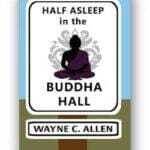 Looking for more on this topic?
Looking for more on this topic? 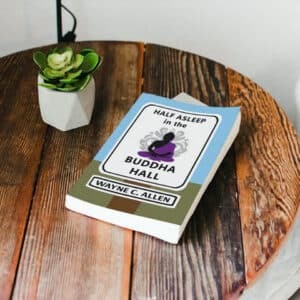 Check out my book,
Check out my book,
Half Asleep in the Buddha Hall.
My “Eastern” book takes you by the hand and helps you to find peace of mind.
Half Asleep in the Buddha Hall is a Zen-based guide to living life fully and deeply.
We have the potential, in dialog, to examine and re-examine both our beliefs and the stories of our life. We can listen to what we tell ourselves, how we describe our situation, and we can begin to understand that, far from being “true,” our stories are simply subjective interpretations of neutral experiences. Once we accept and enact this, we are able to drop the stories, and choose to live in This Endless Moment .
Let me say a word or two about dialog, and then move on to examine the stories we tell ourselves.
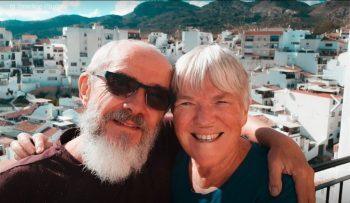 It is essential that each person has a couple of people he or she can be in dialog with.
It is essential that each person has a couple of people he or she can be in dialog with.The reason for this is simple. As we’ll talk about in a moment, one of the essential, and yet very hard tasks is to get a handle on how we interpret our situation. And by situation I mean all of the circumstances of our lives, including the drama of our internal theatre.
We all have blind spots.No matter how far we come along the path to self-understanding and self-actualization, there will always be certain issues that occur that lead to brain freeze.
For example, I’ve spent decades of my life reacting quite negatively to what I perceive as the bad driving habits of others. I yell, I pound the steering wheel, and occasionally wave at the offender with only one finger.
I click over into an instantaneous rage, and I then need to vent. I have no problem venting, and I absolutely believe that getting some of my anger out through steering wheel pounding is likely helpful.
After I calm myself down, I remember that Darbella gets into similar driving situations, and does so without the histrionics.
I decided a while back to discuss my reaction with Dar, (as opposed to defend it,) and to see if I could thwart its “instantaneous-ness.” With a bit of effort, I occasionally succeed.
Our blind spots are a demonstration of an unexplored or off limits mind connection.
All of our behaviours are designed and initiated in the neural networks of our mind. Everything starts as a trigger, which, through our interpretations, builds into a thought and/or an action.
There is some support for the idea that both memory and brain function are non-localized holograms.
A hologram is a wave-interference pattern that appears to the naked eye as random bits of data. It’s like looking at the grooves on a record, or the mirror side of a CD. The music is right there, but impossible to “see,”
in its stored state. However, given the right playback device, the image is restored.
Not only that, but discrete “bits” of the hologram contain the entire “picture.”
According to Wikipedia,
“Since each point in the hologram contains light from the whole of the original scene, the whole scene can, in principle, be re-constructed from an arbitrarily small part of the hologram. To demonstrate this concept, the hologram can be broken into small pieces and the entire object can still be seen from each small piece. If one envisions the hologram as a “window” on the object, then each small piece of hologram is just a part of the window from which it can still be viewed, even if the rest of the window is blocked off.” [http://en.wikipedia.org/wiki/Hologram]
Holographic memory may operate in the same way. All of the data is there, and is made up of bits of information that are the building blocks of memory. These bits of memory can be extracted, lined up, and formed into anything we choose.
Here’s a metaphor for that.
Image you are a film director, shooting a biopic. You follow “Susie” around, and film her for a month. Let’s even imagine that you film her 24/7 for 30 days.
Clearly, no one wants to see 5040 hours of someone’s life. So, you, as the director, first of all pick a theme. It might be “Susie, exercising,” or “Susie, cooking.”
Or, it might be, “Susie, unhappy.”
Obviously, a lot of “the film of Susie’s life” will be irrelevant to the topic you chose.
Let’s also impose a two hour limit on the finished product. Let’s say Susie was unhappy 100 hours in a month. This must be condensed down to 2 hours.
The director started with a blank screen, and then framed the movie thusly,
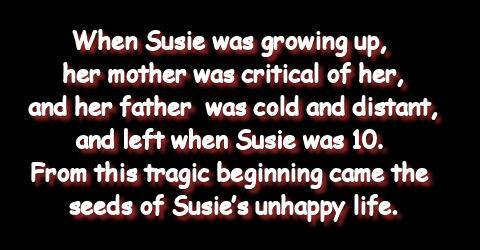
What results is a collection of scenes from the “life of Susie,” selected to reinforce the theme of the movie.
Remember, in our limited example, 4940 hours of stuff is eliminated (the non-sad stuff) and then, 98 additional hours of the sad stuff are also dropped — to get us down to two hours.
The end result is a film that runs from the initial framing-point through to the wrap-up. This entire film is designed, and the scenes cherry-picked, to make (confirm) the frame-point. Here’s the premise, and here is the evidence.
This is exactly how our minds construct internal representations of our day-to-day reality.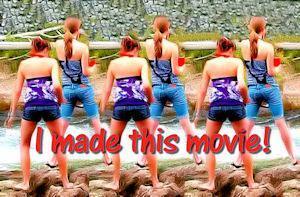
An idea (“I’m abused!” “I’m helpless!” “Everyone leaves me!” “I’m a failure!”) or judgement occurs to us as an interpretation of an event — something happens to us, typically as powerless kids, and we “spin it” to give it meaning. We then cherry pick scenes from our lives to support the initial premise.
Pretty soon, we have a movie that illustrates what we believe to be so.
However, and this is the problem, this movie is not true. It’s a concoction out of a billion other possible scenarios.
Because we have invested time and effort into crafting the movie(s), however, we develop a blind spot.
The blind spot is this: I am the director, editor, and actor in the fictional film(s) in my head.
I forget this, and assume the film
a) depicts what actually happened, andb) demonstrates that I am a passive victim of “life.”So, we repeat the initial, invalid mantra, and add on evidence for a belief that causes us misery.
Dialog is one way through the impasse of a stuck and rigid belief.In therapy, the dialog is simpler, as it is not a reciprocal relationship. The client provides the raw material, the data, by being completely open, and totally honest. The therapist helps the client to see, articulate, and dismantle only the mental dramas that are not functional. (No sense fixing what is not broken”.)
To repeat: The client provides the data through honest and open revelation, and the therapist uses various methods and techniques to challenge “the validity of the client’s movie,” the framing-point, and the usefulness of the story the client is telling.
This work also can be done with one’s principal partner, with a few caveats.Darbella and I are great believers in honest, open, and vulnerable dialog with one’s principal partner. It’s all about having a partner with a willing pair of ears, and listening to their feedback.
That being said, what is not helpful is for one or the other of couple to act as ‘therapist’ for the other. This degenerates into “I’m here to smarten up and fix my partner” — a game that only leads to misery.
Helpful:
Discussions regarding the direction of the relationship, about communication, and about “couple related issues” are fair game for dialog. Self revelation is always acceptable, and highly encouraged. We also establish “word patterns” to remind their partner of “blind spots.” Discovering Blind SpotsTo recap, most people believe that the movies in their heads are true. Thus, when one of these “head movies” runs, they get sucked right in.
It’s analogous to the experience you’ve had in really excellent Hollywood movies. Your “disbelief is suspended” and you are immersed in the action. Time flies by, and you feel emotions arise, and it all seems very real. Then, the movie ends, you give yourself a shake, and reorient yourself to “the real world.”
Now, if a 2‑dimensional celluloid movie can do that to you, imagine what your internal representations can do!
“Tuning in” (being present) to our movies requires noticing our physical reactions. We’re often so wrapped up in the mental movie that we are unable to step back from it. We suggest body awareness — noticing where tightness occurs, where queasiness is felt, where anger arises, etc.
The way out of the mental movie is to notice what your body is doing.Once you identify where and how you react in your body, you can choose to monitor those parts of your body, and “catch yourself” before you swallow the whole movie.
The goal is to “wake up,” much as you do when a real movie ends… to come back into the theatre, notice the screen, and see the actual people around you (as opposed to the actors you were just “relating to.”)
Then you give yourself a shake, get up, and exit the theatre.
“Waking up” is noticing the physical sensations, and using them to become conscious of the dysfunctional movie that is playing between your ears. Once you notice, you can choose to shift your attention back to the actual experience you are having.
Ultimately, our goal here is to get you to the place of informed observation, and choiceful response.Informed observation: our head movies are guides. They are meant to be helpful and retrievable” — “Don’t touch the hot stove!” kinds of things. “When I yell and berate and blame my partner, things deteriorate” is a neutral data chunk. Using it to trigger the, “All men are morons, and I’ll show him!” movie is an invitation to disaster.
Choiceful response: we have to notice our addiction to our movies, or we are doomed to continue to react in non-helpful ways. After we notice, we create a choice. This choice is open, flexible and aimed at the result you actually want.
A choiceful response, arising from an informed observation.It takes both practice and determination to deal with what is going on in the moment, and not to get sidetracked into gathering more evidence of how hard done by you are.
Full and authentic living is living in this moment, without reference to the movies that live in our heads.
Facebook TwitterMarch 30, 2025
About Results — 12 Ideas

Results — The usefulness or validity of an action is always determined by the result. If it ain’t working, doing more of it isn’t going to work either.

Psst! Hey!
** Want more great writing designed to help YOU to shift your behaviour?
** Want to learn how to find, build or deepen your principal relationship?
** Want to know more about Zen living and being?
The usefulness or validity of an action is always determined by the result. If it ain’t working, doing more of it isn’t going to work either. If you’re hammering on some issue and no one else is interested, maybe you need to let the thing go. If you’re ignoring something and hoping it will go away, and it isn’t, maybe you have to deal with it. If you find yourself saying, “It always turns out like that,” maybe you need to try another approach.

I’ve written countless posts and articles about what I call the “Utility Test.” What I mean is, the only determination of the value of an action (or a thought, for that matter) is, “Does it work?”
In other words, does what I am thinking or doing get me the results I say I want?
This test seems perfectly logical, until you apply it to one of your sacred cow beliefs or actions. Then, things get interesting.
Let me tell you a couple of stories.
I subscribe to several Flickr feeds, and one person issued a photo titled “I’d rather be dead than conform.” What’s interesting about her is how often she expresses this sentiment. It seems to arise from her dislike of either negative assessments of, or sexual comments about, some of her photos, notably the nude ones.
She starts by toughing it out and arguing ‘artistic freedom,’ but then ends up angry, sad, or annoyed.
And, her photos are great.
So, it begs the question, “What does she want?”
Obviously, she wants an ideal world where all she receives are complements on her excellent photos, no sleazeball remarks, and no one, no one, questioning her motives or intent. She wants this, really badly.
But the cosmos is kind, and always provides what we fear, just to help us learn. So, quite regularly, she upsets herself that people are not giving her what she wants. Her want is trumped by the behaviour of others — something always out of our control.
It seems to me that she has two real actions that would allow her to “win.” She could:
1) get over offending herself when people comment or criticize, or2) stop posting nude photos of herself.Her option of choice, demanding that others do what she wants them to, is magical, wishful thinking.
To say it again, the only thing that matters is the result.People are typically stuck in one-note thinking and acting. Often the chosen thought path and action can be traced back to childhood — either something the person learned from a parent, and/or a behaviour created in response to a stressor. In either case, the thought or response comes from way, way back — originates in the mind of a child. Or a teen.
And we know how smart kids and teens are.
Now, admittedly, some of that stuff might have actually worked.In childhood.
I remember one client — her dad was also a client. She mentioned how well “guilting him” worked — he was often overseas, and when he got home, she batted her baby blues, and whined about how hard done by she was.
He apologized, then gave her stuff, and also let her off the hook for all of the “Just wait until your father gets home!” threats mom had delivered.
At 35… at 40… older… she manipulated her dad — bat, bat, bat, and out would come dad’s chequebook.
With the men in her life, not so much. They’d initially give in, only to discover that what she wanted from them was endless support, encouragement, and a gold plated pass to do whatever she wanted. So, they’d leave after a few months. She blamed it all on her dad.
The results are all that matter. I don’t waste time analyzing why something isn’t working.In the above illustrations, I trust you can see that the reason their behaviour was getting them lousy results doesn’t matter. In both cases, the people wanted others to change (to support them, no matter what,) and were devastated that they couldn’t get others to co-operate.
I refuse to move off of one of my favourite mantras:
If it ain’t working, doing more of it
isn’t going to work either.
What to do? Try another behaviour. And another, and another, until your results approximate what you say you want.
A framing goal is essential.In the photographer’s case, the only sensible goal is: “I will post my photos and learn from the criticisms of the photos, while deleting and ignoring the brain-dead comments.” In the case of the client, it’s, “I will ask for what I want without manipulation, and without expectation that others will always go along with me.” Or something similar.
If you’re hammering on some issue and no one else is interested, maybe you need to let the thing go.
I remember one woman who ended her marriage because her husband refused to admit that always wiping up water stains from a stainless steel sink was essential for harmony and world peace. No, really. He forgot to wipe out the sink, and she came to therapy, and ended the marriage. Examples like this abound.
Clients provided lists of how they saw the world failing them, and endlessly went on and on about their take on things.
I’d watch their partner’s eyes glaze over, and they didn’t even notice.They expected others to change, all the while saying, “I need you to agree that I am right,” and they got angry and indignantly refused when their partner asked them to change.It was difficult for them to see that how they saw the world was exactly and specifically the way they saw it… and others saw things differently.The way out is to learn to dialogue with others, and, with curiosity, to get to know more about the other person’s perspective.If you’re ignoring something and hoping it will go away, and it isn’t, maybe you have to deal with it.
Many people are deeply in denial. If you mention one of their sticking-points, they either laugh and change the subject, or won’t discuss it at all. Even when a loved one provides feedback that something they are doing is annoying, or not working, or ineffective, and they refuse to examine it.
Ignoring problems and dilemmas, typically by providing endless plausible justifications, is a waste of everyone’s time.I had tons of clients who ignored their odd behaviours and physical symptoms, and eventually made themselves sick. It might be back pain, or heart disease, or cancer. My sense is that the stuff being ignored wants “out”—wants to be taken seriously, and the only way the body has to express itself is through physical symptoms.
If you won’t pay attention to a twinge, perhaps a charley-horse will get the message across.
The only way past what isn’t working is shining a light on the belief / action pattern, without flinching, turning away, or repressing any of it.
If you find yourself saying, “It always turns out like that,” maybe you need to try another approach.
And we repeat, “It always turns out that way” because you endlessly set the same thing in motion. The common denominator of all of your issues with all of those people is… you!
Many people try changing partners, jobs, situations, and get the same thing. For example, they think that if they change partners often enough, they’ll finally find their “soul mate,” which is shorthand for,
“Some moron who will put up with my crap.”
Endlessly searching for the perfect someone who will compensate for the things about you that you are ignoring, or the things that aren’t working, is a great way to waste your life.
We propose relentless self-examination and self knowing, coupled with a willingness to be endlessly flexible with your thoughts, beliefs, and actions.
Facebook TwitterMarch 23, 2025
About Self Actualizing — 12 Ideas

Self Actualizing — Self Actualizing means being in charge of one’s wife through both acceptance and transformative action.
For more on this topic, read:

My first and most popular book,
This Endless Moment.
Learn to live a full and satisfying life.
Self actualization is a term made famous by Abraham Maslow, who extensively researched mental health and human potential. You can read more about self actualization.
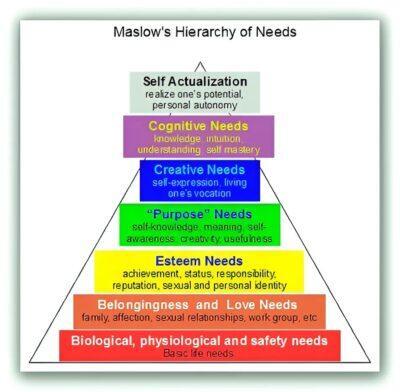 Maslow arranged human beings’ needs like a ladder. The most basic needs, at the bottom, were physical — air, water, food, sleep. Then came safety needs — security, stability — followed by psychological, or social needs — for belonging, love, acceptance. At the top of it all were the self-actualizing needs — the need to fulfill oneself, to become all that one is capable of becoming.
Maslow arranged human beings’ needs like a ladder. The most basic needs, at the bottom, were physical — air, water, food, sleep. Then came safety needs — security, stability — followed by psychological, or social needs — for belonging, love, acceptance. At the top of it all were the self-actualizing needs — the need to fulfill oneself, to become all that one is capable of becoming. Self-AcceptanceMaslow thought that any unfulfilled needs lower on “the ladder” would inhibit the person from climbing to the next step. Someone dying of thirst quickly forgets their thirst when they have no oxygen, as he pointed out. People who dealt in managing their higher needs were what he called self-actualizing people. Benedict and Wertheimer were Maslow’s models of self-actualization, from which he generalized that, among other characteristics, self-actualizing people tend to focus on problems outside of themselves, have a clear sense of what is true and what is phony, are spontaneous and creative, and are not bound too strictly by social conventions.
[from http://en.wikipedia.org/wiki/Abraham_Maslow]
We proceed from the assumption that people are, at all stages of their development, both OK, and complete. This is what we mean by acceptance, or better, self-acceptance.
That this is not the normal belief is obvious. We are trained from birth to judge ourselves as “lacking” and also “wrong, bad, and/or evil.”
Most simply want symptom removal, which is interesting.When I ask what they want in place of the symptom, most say something like, “I just don’t want this [pain, depression, faulty relationship, anger, etc.] anymore.”
It’s like asking someone, “What do you want for supper?” and hearing, “I don’t want steak.” Negative statements are a problem, because it is impossible to list all of the things we don’t want.
All things clients name, like anger, depression, sadness, being judgemental — these things are actually symptoms of just one thing — a lack of resources for doing things differently.
In other words, situation ‘a’ happens, and you react with anger. Situation ‘b,’ (which is totally different from situation ‘a’,) arises,and you react with anger. And so on.
Unpacking, this means,“No matter what arises, the only thing I know to do is
to get angry.”
Think about it. The solution is not to eliminate anger. The reason? Well, what will take its place?
Rather, one must begin with acceptance. “Here I am, at this stage in my life, and when confronted with a difficult situation, I have trained myself to respond with anger. This is no longer working for me, so I will instead teach myself to [engage in another behaviour.”]
This new behaviour falls under the category oftransformative action.
We call it this to differentiate it from mindless action. The way out of the fog of repetition is to engage in thought-ful behaviour (behaviour that has been designed, through reason, to accomplish the end goal.)
Let’s say you have this goal:
to stop fighting with your partner, and then to deepen the relationship through elegant communication.
You could see this as a two step goal.
The first step is to notice both your anger, and when you are beginning to fight.
Let’s call this self-knowing.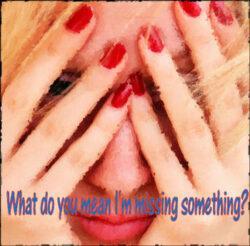
It’s amazing how many people do not have a clue what they are doing.
I once spent 20 minutes in a group listening to a woman accuse the other members of the group of not letting her speak, and how everyone always interrupted her, and kept her from speaking.
Now, she was never once interrupted in 20 minutes, other than for the leader to encourage her to keep talking.
She was so clearly invested in her belief that she was unaware that she was receiving exactly what she craved.
Once you notice that you have moved down a path you want to stop trodding, you stop yourself. Without judgement. This is the tricky part, as, to say it again, we’ve been trained from birth to criticize ourselves for our supposed failures.
If you think about it, however, criticism is a poor motivator. It’s much better to notice, then stop, the errant behaviour.Here comes step two:
Self-responsibility.Not only do I accept that I am who I am, (up to and including the present moment, where I “stopped myself,”) but I am now at the transformative action crossroads. I can avoid fighting, and this is a great improvement, but falls short of the second part of the goal: to deepen the relationship through elegant communication.
In order to accomplish this part of the goal, I have to now move my lips in another way altogether.
So,
I notice, andI stop myself from engaging in non-helpful behaviours.I remember my goal and implement it.
The self-responsibility requirement makes the choice to act a solo job.
Thus, I deepen the relationship through elegant communication, regardless of what my partner is doing.
Mostly, people fight this. “How can I improve my relationship if my partner refuses to co-operate?”
I want to assure you that, 100% of the time, such a question is a cop out.It’s a cop out because how you self-actualize is 100% about how you act, and how you choose to define your reality. It does not, and never has, had anything to do with the behaviour of another.
In the end, all we can ever do is what we do as individuals.Get this! Anyone can choose to communicate with anyone, and it does not require that the other person communicate back, give permission, or change their behaviour.
Now, granted, it’s easier if both parties are on the same page, but it’s not required.And waiting for others to co-operate in your self-growth project is setting yourself up for a long, long wait. Great excuse, though. I can’t do this until everyone else behaves. Good luck with that.
Yet, I see this all the time. People annoyed with their partner, parents, kids, bosses, whomever, and stomping their little feetsies up and down, exclaiming, “Why can’t they see how unhappy they are making me, and do it my way?”
It’s as if they never grew up, and are still expecting magic to change the rest of the world, so they can stay the same.We urge self-responsible, transformative action. All the time, no excuses, no waiting, no blaming, judging or criticizing. There is what does not work (stop doing it!) and what does (start doing it!) Plain and simple.
Facebook TwitterMarch 16, 2025
About Taking Action — 12 Ideas

About Taking Action — Living your life is a solo project, undertaken in the presence of friends. This step involves a sustained, aggressive, and non-judgemental examination of who you are, what you are doing, and how you are framing your reality. The essential component is non-judgement.

Living Life in Growing Orbits is our workbook.
52 weeks of daily exercises designed to help you figure yourself out.
Check out Living Life in Growing Orbits

For each of us, the path to self-knowledge is a spiral. We go inside and review what we are about, what we “know,” and what we are enacting. We look for blocks, fears, terrors. We reveal our thoughts, feelings, fears, and joys with a select few‑a principal partner, therapist, spiritual director, and Bodyworker. We devise ways to let down our walls and let out the repressed material. We then take in the perspectives of those whom we respect, and use this feedback to nourish more self-knowing.
Actually, this particular process is a spiral, but we’ll get to that in a moment.
I’d like to propose, from the above, that 5 steps or processes are required.They are sort-of-sequential, and repeat throughout your exploration, for your whole life (that’s the spiral part.)
1. Self-examinationLiving your life is a solo project, undertaken in the presence of friends. This step involves
a sustained, aggressive, and non-judgemental examination of who you are, what you are doing, and how you are framing your reality. The essential component is non-judgement.
Judgements are actually excuses for staying stuck, which is what this circular-spiral path combats.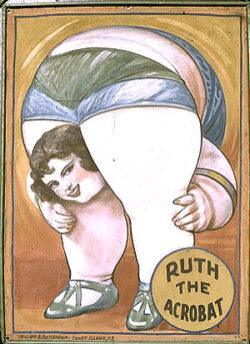
Most people, by the time they get into their 20s, have developed a shtick–a way of presenting themselves–to themselves and to the world.
The odd part is, this shtick is a progression out of the data of the childhood and teen years, and we all know how intelligent and well-versed-in-life children and teens are.
Nonetheless, this script is adopted holus bolus, and when evidence of competence arises, the script is altered to discount the new evidence.
A key part of my therapeutic approach was what I called Radical Disinterest:I had no interest in hearing or discovering where this infantile self-view came from.I was not particularly interested in the story clients had constructed to support their non-functional beliefs.I also did not see much value in debating these beliefs–although this was actually what most clients thought therapy was all about.
Let me give you an analogous situation. You go to a mechanic, who proceeds to tell you about all of the cars he’s broken, all of the mis-diagnoses he’s made, and then he says,
“Well, I’ve never successfully fixed a car, but I have a great set of tools, and lots of books, and I figure that if I keep doing what I’m doing, eventually I’m going to get it right.
No sense getting advice, learning to do things differently, or exploring other options–after all, I learned how to break cars from my dad, who told me it’s just the way I am.
Now, when do you want me to start working on your car?”
Most folk believe that internal states–how one feels, thinks, reacts–are out of their control.
They are correct.
Our patterns are ingrained–they are as much a part of us as our eye colour. This is why having a long conversation (or years of “depth therapy,” about this) is essentially meaningless.
On the other hand, wise folk realize that it’s like this:
“This is my nature, this is how I mess myself up, and here is what I choose to do differently, this time.”
Your key task is to examine how you do life. Pat yourself on the back for what’s working, and then bring your attention to what isn’t. Figure out the pattern. “When ‘a’ happens, I always go into self-judgement, and curl up in bed, and feel sorry for myself.”
Then, move to step 2.
2 — Search for blocks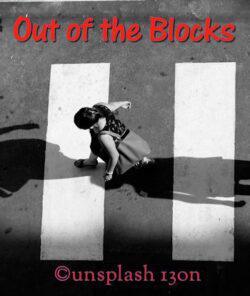
We are not made up of parts. We are whole.
While Westerners are good at slicing and dicing (“Here’s my mind, and it’s different from my armpit,”) it is only different as to function.
You are all of you, and an essential part of self exploration is learning to read your body for your blockages and containerizations.
Blockages: Our bodies are perfect in their responsiveness. In other words, our bodies reflect the state of our mind (they’re the same thing, actually) and the results of our actions (it’s all the same process.)
Example: if I get angry, there are physiological changes. Muscles tighten, and the free flow of energy is restricted (as is blood flow to extremities, and the gastrointestinal system slows down or stops.)
Searching for YOUR blocks is becoming intimately acquainted with where in your body you hold stress. You do this by noticing, and then monitoring. As you think, react, and act in the world, a part of you pays attention to your body, asking,
“How am I, right now? Am I tight or loose?”
Containerizations: metaphorically, our bodies “hold” blocked energy, just like a cup holds water.

A common container is for our grief: grief “stacks up” on the chest; actually, below the sternum.
Our chests — the heart area — hold this “grief energy.” It’s why we say, “I’m heartbroken” when someone leaves us, as opposed to, “I’m broken-kidney-ed.”
Each of us has one or more favourite places to hold stuff, and paying attention (perhaps during a Bodywork session) helps you to discover yours.
3 — Open revelationIn the top quote, I mention people to open up to–a principal partner, therapist, spiritual director, and Bodyworker. This is the ultimate goal, and the last three could be the same person.
When I say principal partner, I do not necessarily mean a spouse or life-partner. I mean that everyone needs at least one person who is not a professional, with whom they share “What’s up” for them.
This is someone with whom I choose to be open, honest, and vulnerable. I commit to letting this person in on what I am thinking, how I am hurting myself, and what I intend to do with my life and my life-choices.
This person has permission from me to hold me accountable–to remind me that I am committed to doing what I say I’ll do.
This relationship must be reciprocal.
Good friends can act in this role for each other, long-term, or short-term. The “Good Friend Contract” is to listen, to reveal, and to “let it all hang out.”
A Principal partner can also help you with Bodywork, not to replace, but to augment a professional.
Darbella and I work on each other’s bodies regularly–any time either of us notice holding. We do the physical part with each other, without getting into “diagnosis.” I’m not Dar’s therapist, and she’s not mine.
With your good friend or principal partner, you ask for some pressure on a holding point or a container–the partner provides the pressure, the shoulder to cry on, and some Kleenex.
Professionals: If you are working with a professional who is willing to take responsibility for your life, run for the door, rapidly. While your relationship with the professionals listed will be deep and intimate,
it’s a one-way street, andit’s purpose is for the client to receive the therapist’s reflection– to reflect your choices and understandings back to you, and to make suggestions regarding alternative interpretations and behaviours.It is not the therapist’s job to get you to do anything–that’s your job.It’s not the therapist’s job to persuade you to “see things the therapist’s way.”Therapeutic mirroring helps you to see the results of your choices, directly and without judgement, and then to make other choices.4 — Letting goIt’s not enough to talk about this stuff.
The key to living life with depth and elegance is “doing.”It is not what people intend–it is what they do.
Let’s say you buy a copy of my book, The. Best. Relationship. Ever.

The. Best. Relationship. Ever.
You commit to talking with your principal partner, in depth, for 30 minutes per day. The only thing that matters is this: “Did you do what you said you’d do?”
Many people are expert at excuse making. Excuses are nothing more than laziness. Our egos are invested in our staying stuck, so they provide an excuse so you can keep reacting in old ways.
It’s important to note that this work is solely self -responsible.Taking Action is not a tool to get others to change, and there’s no expectation that others are “going to” cooperate with our work. We learn to stop disturbing our own tranquility as others do what they do.
It’s not the job of others to walk in front of you, filling in the holes and keeping you from falling over.
5 — Shift behaviour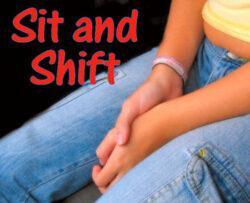
i see this as such a key to this work, that I gave it separate billing, despite the other 4 also being “behaviour shifts.”
To say it again, the only important thing in all of this is what we choose to do.
Many people “get” what I write or talk about. It makes sense, until it collides with one or more of their sacred cows. Then, out come the stories, evasions, and excuses.
And inevitably, the stories reduce to “Others have hurt me and made me powerless,” or “I’m dysfunctional, and incapable of making other choices.”
We say, “Others did what they did, and you are who you are, and every time, there is choice.”Many, many people give up at this “choice point.” It’s as if they have so much invested in the “sacred cow,” that they’d rather stay stuck and in pain. They’ve viewed their reality according to a “helpless” model for so long, that dropping it seems impossible.
Oddly, it IS impossible.As I said above, those voices of helplessness are as old as you are. They are not going anywhere. Your history is your history, and we’ve all experienced “bad stuff.”
Thinking, “That shouldn’t have happened,” while perhaps true, is a waste of time contemplating, as what has happened is what has happened.
We suggest acceptance of ourselves as we are.Then, work from there.
So, as the “helpless voice” arises, you learn to be tolerant and sympathetic of yourself. You hear it, honour its existence, and then make other choices. Again, and again. Until you die.
The “choice to make another choice” requires vigilance and diligence.Our tendency, like in the ‘mechanic story,’ is to do the familiar, while justifying the non-functioning behaviour. We need to learn to stop ourselves, and to experiment with other ways of being and acting.
Much like changing any bad habit, shifting to another way of being and acting takes time. Beating up on yourself for missing an opportunity accomplishes nothing, so you might as well just get back to doing the new thing, as soon as you notice you’re off track.
The spiral
Finally, let me note that “life is a spiral”… because personal work goes on and on.
It’s like we are walking up a spiral staircase. We get better and better at implementing our new understanding, and then we confront a more complex version of the same issue, and are once again thrown into confusion.
The way out, however, never changes.
You enter the sequence of 5 steps again, only this time, with greater understanding. You see through the illusion you are creating, and shake your head, stop the non-functioning behaviour, and engage with life self-responsibly.
Around and around we go, and we soon see that the pattern of engagement never changes.
What arises, arises, and we want to grab it and make it big, scary and important. We have a breath, relax our grip, let go of the emotions, and take the next step. And the illusion we have created goes “poof.”
This is the only “real” game in town.
Facebook TwitterMarch 9, 2025
About Anxiety — 12 Ideas

It is impossible to live life free of anxiety . There is the anxiety that comes when deciding to shift one’s way of being–the anxiety of change, of pain, of growth. And

Psst! Hey!
** Want more great writing designed to help YOU to shift your behaviour?
** Want to learn how to find, build or deepen your principal relationship?
** Want to know more about Zen living and being?
One of the things I’m most interested in is the idea that we can shift our understanding of how life is, how we relate to ourselves, to others, and to the world.
But the weird part is that we are fighting against our natures–our egos–which are highly invested in keeping us stuck in society’s view of “normal.”
Anxiety, then, might be seen as the result of what happens when society’s — our ego’s — demands do not match our reality or our experience.
The problem comes when we think our ego view should trump what’s actually happening
While I could be accused of exaggerating here, most people have a pretty common view of how life ought to be. I call it the “Bluebird of Happiness” model.
I coined this idea after thinking about the little cartoon bluebirds that flitted about in cartoons I saw as a kid. My favorite one is shown here: Uncle Remus and the bluebirds, from the Disney movie, “Song of the South.”
This particular model elevates happiness to the pinnacle
The odd part is that it is impossible to define happiness.
Happiness is highly subjective, and, it seems, something that is always just out of reach. The founders of the United States got it right — they listed unalienable rights, one of which is “… the pursuit of happiness.”
Happiness is something we chase, but never quite catch. It’s “out-of-reach-ness” is what causes our anxiety.Anyway, here’s a list of the “bluebird” expectations many people implicitly or explicitly have:I will always get what I want, when I want it.I will only be in relationship with people that love and respect me.If I have children, they will be bright or even exceptional, everyone will love them, and they will succeed in everything they do.* People will find me interesting, attractive, and will desire me.My primary relationship will work on autopilot, because I am with my soul mate, who has nothing better than to do than to be everything for me, to do my bidding, and to make me feel good about myself.Money will flow through my fingers like water, but there will be a pot of gold at the end of the rainbow.True success is measured in the size of the pile of stuff I’ve accumulated.People who love me always agree with me.It’s my right: to demand that my feelings take precedence, to blame others for them, to express them harmfully, and to be endlessly forgiven for whatever I dump on whomever I choose.I do not think that I should have to put any effort into communication, because if I am misunderstood it’s the fault of the other person.I know that happiness is just around the corner, so I’m just going to keep doing what I’m doing, as I wait, breathlessly, for everything to “work out.”Now, you may be thinking that this very long list doesn’t apply to you at all.I’m not saying that every person believes all of these things. What I am saying is that most people that I’ve met over my seven plus decades are pretty much stuck in this general belief system.
They’re so caught in the drama that they miss the pattern.One person I know, for example, gets into a “blaming cycle” about every six weeks. She tells me of the latest affront — and it always has something to do with others not agreeing with her perspective, or demanding that she change — and how she’s not going to put up with it.
What changes is the specific “unfairness” she is presently mad about.
What she misses is the pattern of being affronted every six weeks.Until she can step back and see the pattern that she is creating, she is doomed to repeat her dissatisfaction. Her approach, 100% of the time, is to literally or figuratively leave the relationship. And then she goes out and does it all over again, with someone new, or she creates a new situation with someone old.
To restate the key point of this section, the anxiety she creates regarding her dissatisfaction with others is more appealing than the anxiety she imagines she would feel if she dropped this approach and did something different.
It seems to me that the work of adulthood is to challenge our presuppositions.In other words, to examine what we believe in the cold light of reality.
Is it really possible to have a healthy relationship by demanding, endlessly, that our partner change — judging that everything is his or her fault?Is it really possible to motivate ourselves to change through endless self-criticism and judgment?Is it really possible to expect that all of our wishes will be granted, just because we want something, and without ever considering how our wishes clash with the wishes of our nearest and dearest?This is not to suggest that you start doing life the way others want you to. That’s what got you into this mess in the first place.This is a prescription for direct personal observation, and clearheaded evaluation of the results you are getting regarding the choices you are making.
Being an adult, then, is demonstrated in our willingness to drop behaviors that don’t work — I think that is only possible when we are willing to drop our invalid beliefs. I call this “ The courage not to be yourself ” model, because it takes great courage to drop what we always do in favor of what works.
And the only way you discover what works is to do it.Our approach, then, is twofold.
First, you must be willing to explore each and every one of your beliefs, in order to gain perspective on how you stay stuck — repeating the same old stuff. As I noted in the long paragraph on silly cultural thinking, these weird beliefs are hooked into happiness, as in, “If only people understood this rule, and changed their behavior, and gave me what I wanted then I would be happy.”Second, you must be willing to face the anxiety of change . I want to be clear here. You are changing your behavior, not your essence. What I mean is your beliefs are as old as you are, and are going to be there until you die. There is no way to get rid of them. There is a way to make peace with them. As they arise, we hear them, we acknowledge them, and we let them pass without enacting them. This is hard, hard work. Anxiety provoking work. Most people would rather remain stuck.As I wrote in my booklet, “The Watcher, your goal is to create an alternative voice, another perspective, a clearer, more direct, and elegant approach to life. With time and with practice, this voice becomes the dominant voice in your head, and the process of choosing efficient behavior becomes simpler.
But as with any new learning, the learning curve is the steepest at the beginning.We start from a place of accepting where things are, drop the endless bitching, accept ourselves as we are, and then make better choices.There’s nothing particularly complicated about this view. It just requires persistence. Once you understand that “the way it is, is the way it is,” once you fully land in this moment, you are suddenly aware that without preconceived notions your options are endless.
It is the one and only way out of the labyrinth. Labyrinths require courage, creativity, and making friends with your anxiety, so that you can discover the way out.
And having a guide that has conquered a labyrinth doesn’t hurt, either!
Facebook TwitterMarch 2, 2025
Bring Wisdom — 12 Ideas

Bring Wisdom — If life has any meaning, it is this: each event of life has the potential to bring wisdom. The wise person is able to see through the events of life to their essence, in a moment of simple engagement.

Living Life in Growing Orbits is our workbook.
52 weeks of daily exercises designed to help you figure yourself out.
Check out Living Life in Growing Orbits
Part of the game of life is learning to see through the ‘rules’ to a clearer understanding of what’s really happening.
Here’s a thought for you:

You are the centre of the universe.
No, really.
Take a look around you. Everything that is “out there” has you as it’s centre. All the way out to infinity. There’s stuff all around you, all the time, and there you sit, right in the middle of it all. Other people surround you.
8 billion of them, on this planet, all rotating around you .I’m only kind of joking here, as this is actually how it is.
Of course, it’s also true for everyone else, meaning that there are, on this planet, 8 billion centres of the universe.
Our conditioning tends to mean that we forget that what applies to us applies equally to others. We get caught in the, “me, me, me” drama quite easily. Back when I was working with a new client, this was the first issue we dealt with.
Many, many moons ago, like 16 years or so, Darbella took this photo:
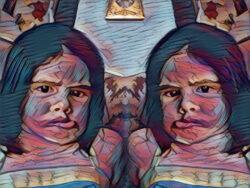
Our 6 year old grand-niece was flitting from one thing to another. She butted into every photograph being taken, made countless demands on the adults–for food, time and attention.
At one point, she turned up the volume on the stereo, and then got annoyed that the adults were talking.
Clearly, she saw (and still sees) the world as her oyster, and the rest of us as pawns in the game she is playing.
We make allowances for this behaviour in our children.It’s harder to call people on it as they grow up, or get older–perhaps the better choice of words.
One woman of our acquaintance, who endlessly does a ton of self-development work, used to annoy herself regularly, and then start, literally, running around the house, screeching while loudly complaining that we weren’t taking her seriously enough.
This was always connected to her threatening to leave–“I’m going to take my toys and never come back! So there!” She’d get even more annoyed when we didn’t give in to her or ask her to stay.
Clients would list off multiple things that they judged had gone wrong with their livesThey had bad genes, or had trouble keeping their jeans on, or they couldn’t find someone who wants to take them off. They declared that they were sad, or depressed, or angry, or bored, or disgusted, and everyone around them “keeps doing stuff that “made them” stay caught in their bad feelings. They’d endlessly tell their defective partners what to do and were furious when the partner (or parent, or sib, or child) wouldn’t listen, change, and thank them for their great advice.Sitting in the middle of their universe, surrounded by the mess that they’d made, they’d adopt the face of the beatific 3‑year-old, and say, “Who, me?”
I’d ask them to do one thing–to accept that the mess around them is their mess.How you are, who you are, and with whom you are in relationship (and with what–jobs, bank accounts, debts, education level, etc.) all of this is there, in yor life, by your choice choice.
You are indeed the centre of your universe, and like the sun, you exert gravity–you attract stuff. That great sucking sound is you, creating your life.If you expect that any of this is going to change just because you want it to, without you having to first, accept responsibility for it, and then to change something–well, good luck to you.
The only way to change your life is to accept that what surrounds you is yours, and who you are is you!Once you make this concession–once you stop blaming fate, or god, or Trump, or externals for dumping this stuff on you–you have the chance to shift your relationship to life.
For now, let’s just see what this sort of wisdom might look like.First of all,
Life is exactly as it appears. Life is going on around you, people are doing what they do, the economy is doing it’s thing, wars are fought, and from the ridiculous to the sublime, this is life. People are going about their lives, and life is going on.People do what they do. No one is doing stuff to you. Now, sure, some crappy stuff may happen to you, but that’s just what happens. Accidents happen, of course, and you didn’t deserve it — you’re not being punished, etc. People around you are acting from within their own universe, and do what they do from within their experience and understanding.You can’t prove anything to anyone. Your perspective is so unique to you as to have no other match in the universe. Stuff means what it means to you.Wasting time trying to get others to declare you right is futile.Wisdom is working with yourself — all aspects of you, from where you are, without a ton of time spent trying to figure it all out. You start where you are, make choices about what you want to experiment with next, and you evaluate your experience based upon actual results.There is no need to continue to play with the mess you’ve created.All that’s required is a broom and dustpan.
That most people would rather play with the mess, and feel sorry for themselves, does not mean that this changes the mess.
Wisdom is twofold here.
First, you admit that you, and you alone, have created the life you have right now.
Second, you decide that you’re not going to stay stuck in the mess out of stubbornness, lack of motivation, or confusion. You’re going to clean things up, recognize the triggers that got you stuck in the first place, and as those triggers arise, you’re going to walk rapidly in the other direction.
True wisdom is recognizing that nothing has to happen the way it has always happened, nothing means anything other than what you make it to mean, and satisfaction comes from doing what works and dropping what doesn’t.
Facebook TwitterFebruary 23, 2025
About Reality

About Reality: learning to be in the present moment, in the real, is key to waking up and living a full life
For more on today’s topic, check out:

An excellent guide to life and living.
Learn to focus your attention of who you really are.
Read This Endless Moment now!
I’ve been reading Brad Warner’s books on Zen for decades, and also subscribe to his blog. He isn’t writing blog posts as much these days; here’s an old. interesting one: “The Age of Reality.”
Here’s a quote:
It’s a key Buddhist principle that what is right in front of you is all that there is.Nishijima Roshi: If Buddhism pervades throughout the world, religions will vanish. That is my idea. Religion is a kind of belief, but Buddhism is believing in the fact in front of us. So the attitude is different. I think human history is going to enter into the age of reality.
Q: And the age of reality means the age of looking at what’s in front of us?
Nishijima Roshi: Yes, based on the fact at the present moment. And in that situation religious thoughts cannot exist.
Which is a hard thing to swallow, given our desire for things like permanence, security, and specialness. All of these things require something “other” than reality.
Religion is Belief-based, not Reality-basedReligions develop, typically, after the death of the guy who started things off.
Back in my Seminary days, I studied the chronology of the New Testament writings. (Paul’s letters came way before the writing of the Gospels. Paul wrote from around 48–67 AD. Mark, the first Gospel, was written around 70 AD.)
It’s clear Paul hadn’t a clue about the historical Jesus–he didn’t really quote him, and never knew him.
Paul was building a religion, but he had a problem: he had to deal with a dead guy, or a resurrected but no longer around guy. So, almost immediately, he started writing, and we presume, preaching, that Jesus was going to return, and bring justice, otherwise known as crushing Rome.
In Paul’s earliest letters, he promises this “immediately.” Then, a bit later, he promised a return in Paul’s lifetime.Years later, at the end of his life, having looked and looked and not seen any such “return of the hero” Paul wrote, “soon.”
It’s now 2000 years later, and “soon” is not here yet.
I’m not disparaging Christianity. I’m just saying that lots of people, Paul included, want a vengeful, sword-wielding Christ, as opposed to “Gentle Jesus, meek and mild.” They want him to crush “Rome” — a Rome made up of people they hate.
The nuts and bolts of “do unto others” living as Jesus instructed pales, for many “Christians,” when compared with avenging gods.All that “do unto others” stuff is hard to stomach when “others” are judged to be inferior, especially if they are a different race or religion or gender.
So, better to focus on meting out “justice.”
You get this in Islam, too, where you see stuff about 72 virgins and paradise, as a reward for attacking and killing “infidels.”
Buddhism, as a philosophy, or life-focus, skirts away from this “other-worldly” focus. Sure, some strains of Buddhism have added in reincarnation, but that’s arguably not really Buddhist. In fact, the Buddha was pretty cool about other-worldly things:
“I do not care to know your various theories about God. What is the use of discussing all the subtle doctrines about the soul? Do good and be good. And this will take you to freedom and to whatever truth there is.…”
I like this… and it’s my point.
There’s nothing wrong with believing in God, or heaven, or whatever. But simply recognize that what you believe about anything that isn’t right in front of you is what you believe, and is therefore imaginary.
Period.
Reality, on the other hand, is pretty obvious, as it’s right here, right now. It’s what you see and hear. It’s also the feelings that arise in you, but not necessarily your thoughts.
The stories, fantasies, dreams, etc. that go on in my head are not reality. They’re constructs, invented by me.
Just because you can imagine a giraffe with the head of Donald Trump, doesn’t mean such a thing exists.
What exists, what is real, is all that is of importance.We therefore encourage everyone to get real and to be real. To stop with all of the “I’m sure my stories are real,” or “Here’s what going to happen” stuff, and to simply act in this moment.
Not for any pressing, future-based reason, but because this situation, right now, will be addressed by me like this, right now.We resist all of this because reality can be messy, bloody, nasty… and having some magic story about it all seems the better option. Or praying about it seems like a good choice. Or griping and complaining.
And as we play all of these games in our little heads, reality is still… reality.As our self-generated drama goes away, we’re back to the reality of life. And the next question: given this information, what do I need to do?
Reality… that which is right in front of us, waiting to be seen, heard and responded to.
The Age of Reality. The place we really live.
Facebook Twitter


